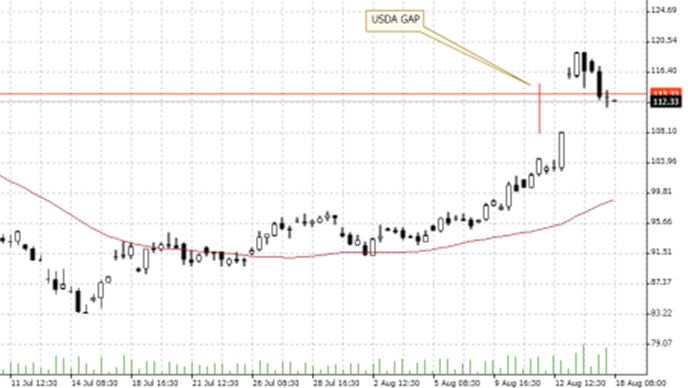

18.08.2022 – One word is in high season in the English-language financial and trade media: megadrought. The mega-drought is driving up the prices of soft commodities. Especially that of cotton.
Water level down, cotton price up: Not only in Germany are the levels of rivers and groundwater dropping. But also in the USA. Ergo, the price of cotton recently moved upwards, see here in the four-hour chart. The question is whether a return to the 50 moving average is not now gradually in the offing. And whether the gap torn by the U.S. Department of Agriculture is not just closed again.

Source: Bernstein Bank GmbH
What had happened: Last Friday, USDA lowered its U.S. crop estimate by about a third to 12.57 million bales – the lowest in a decade – because of sweltering heat in Texas. The United States slipped from the world’s third-largest producer to fourth.
US yield collapses
Specifically, USDA said for the U.S., “Production in 2022/23 is forecast to fall roughly 5.0 million bales to 12.6 million because of drought, particularly in Texas which normally accounts for more than one-half of U.S. plantings.” And, about two-thirds of U.S. cotton acres are currently affected by drought. According to the U.S. Drought Monitor, half the nation is suffering from drought.
Wasteland in Texas
The cotton bull market could continue, as the crop appears irreparably damaged. “I don’t think you can put a top on prices right now,” Louis Barbera of VLM Commodities told Bloomberg. He continued, “I have been going to Texas for more than ten years, and this is by far the absolute worst I have ever seen.” In the South Plains of West Texas, large areas of plantations have now withered. The region around Lubbock, Lamesa and Amarillo resembles an absolute wasteland.
Sharp drop in exports
And could a recession choke off demand? That’s not an issue – yet. According to the USDA report called “Cotton: World Markets and Trade,” the drop in exports currently far outweighs the drop in imports for processing worldwide. Literally, it says, “Global trade is down with a 342,000-bale drop in imports and 642,000-bale drop in exports.” But, China, Bangladesh and Pakistan are importing less and less according to the 2021/2022 Trade Outlook. An indicator of a dent in textile production.
Recession versus rain
The conclusion from all this is that prices are not likely to turn south again until there is heavy rainfall. And also as soon as there are signs of a recession in the important consumer countries of clothing and furniture. The tipping point could be reached soon, because inflation will sooner or later lead to a buying strike – people will save on everything that is not essential, i.e. everything except food and energy. Especially if there is a threat of job loss on top of inflation.
Finally, it should be noted that, conversely, things could get much worse. Because what the green-left climate church rarely if ever mentions is the fact that even more catastrophic droughts have always existed – and long before industrialization. Do some googling under the dates 1302 to 1307, 1540, 1718, just to name a few. For us, Bernstein Bank is keeping an eye on the situation for you!
Important Notes on This Publication:
The content of this publication is for general information purposes only. In this context, it is neither an individual investment recommendation or advice nor an offer to purchase or sell securities or other financial products. The content in question and all the information contained therein do not in any way replace individual investor- or investment-oriented advice. No reliable forecast or indication for the future is possible with respect to any presentation or information on the present or past performance of the relevant underlying assets. All information and data presented in this publication are based on reliable sources. However, Bernstein Bank does not guarantee that the information and data contained in this publication is up-to-date, correct and complete. Securities traded on the financial markets are subject to price fluctuations. A contract for difference (CFD) is also a financial instrument with leverage effect. Against this backdrop, CFD trading involves a high risk up to the point of total loss and may not be suitable for all investors. Therefore, make sure that you have fully understood all the correlating risks. If necessary, ask for independent advice. CFDs are complex instruments and are associated with the high risk of losing money quickly because of the leverage effect. 68% of retail investor accounts lose money trading CFD with this provider. You should consider whether you understand how CFD work and whether you can afford to take the high risk of losing your money.7
